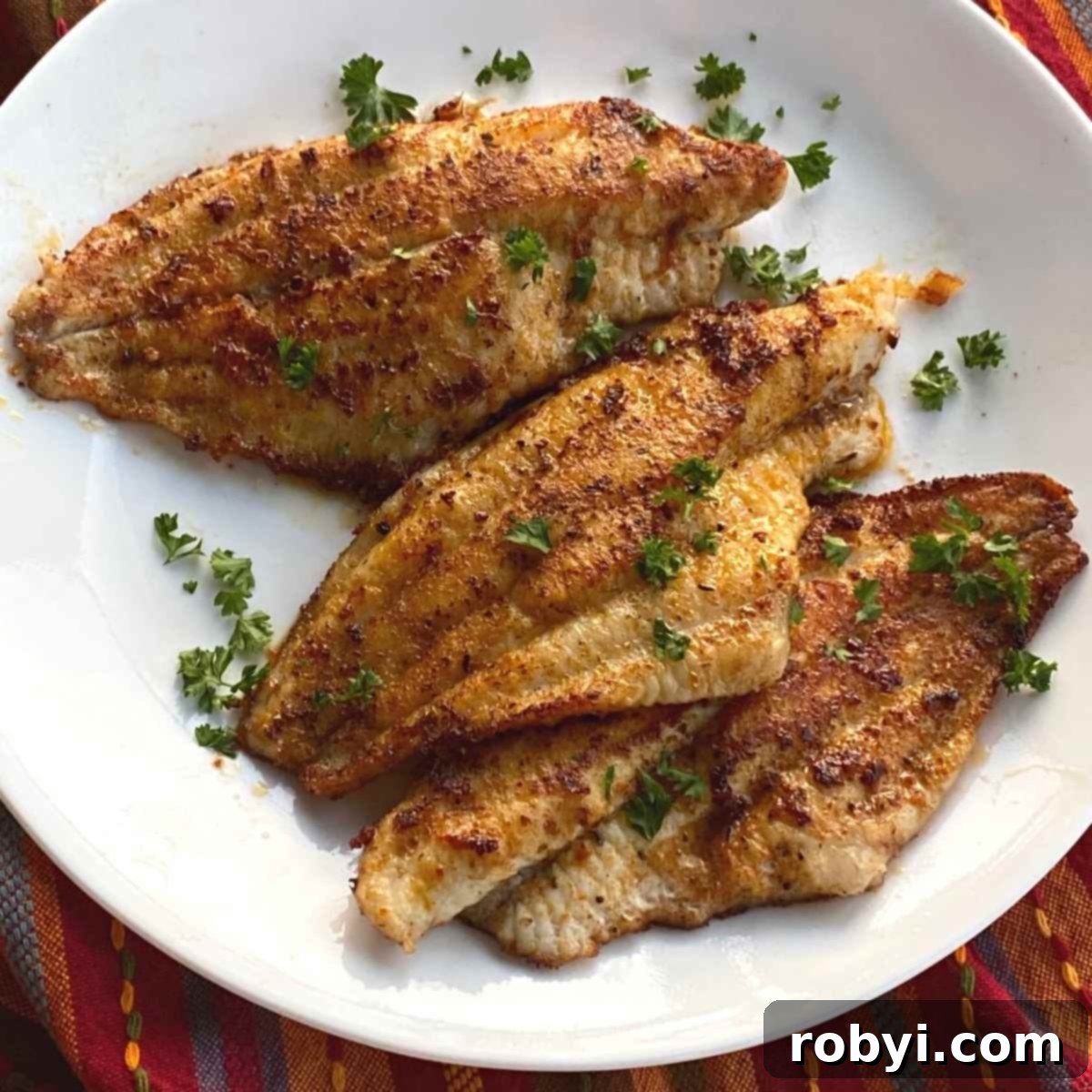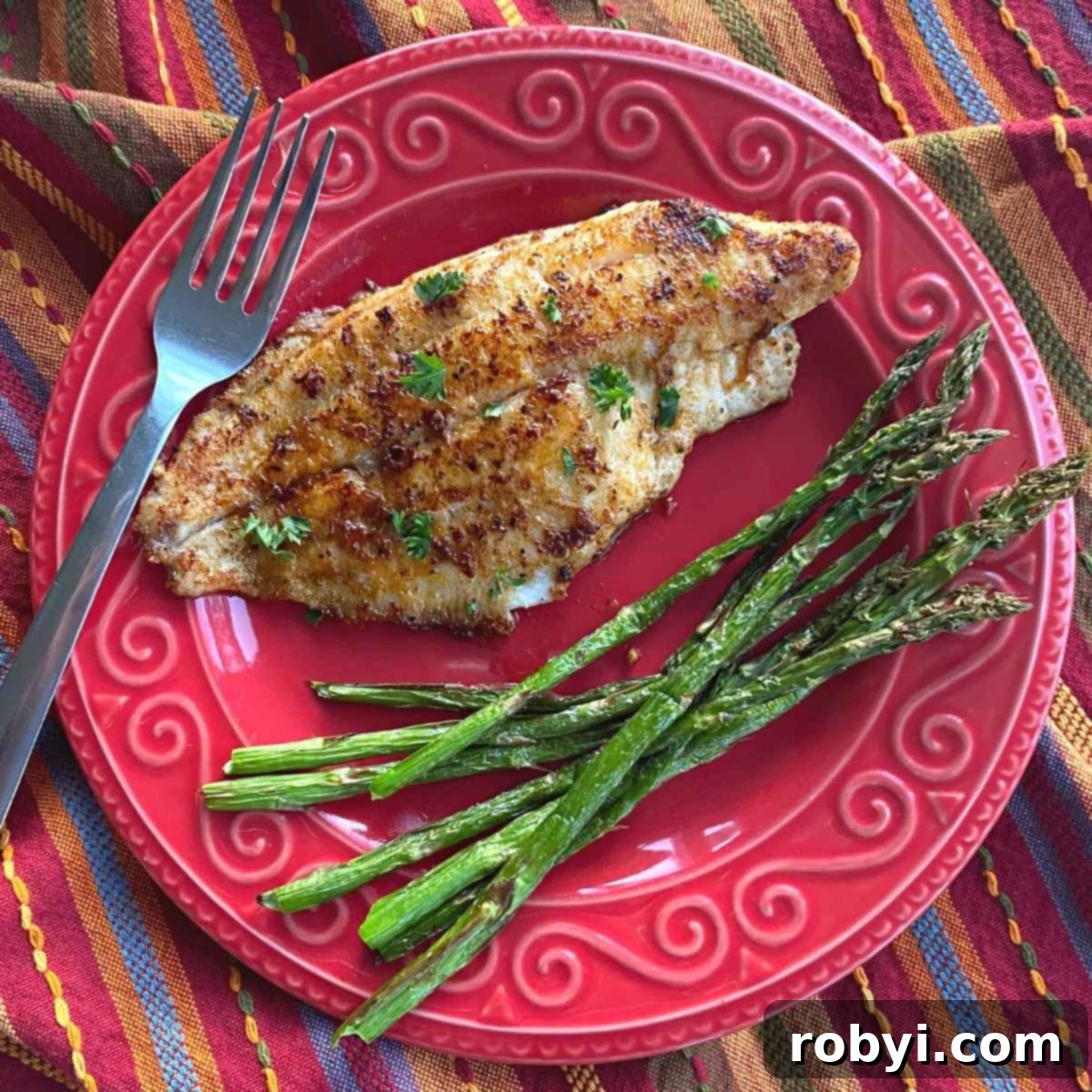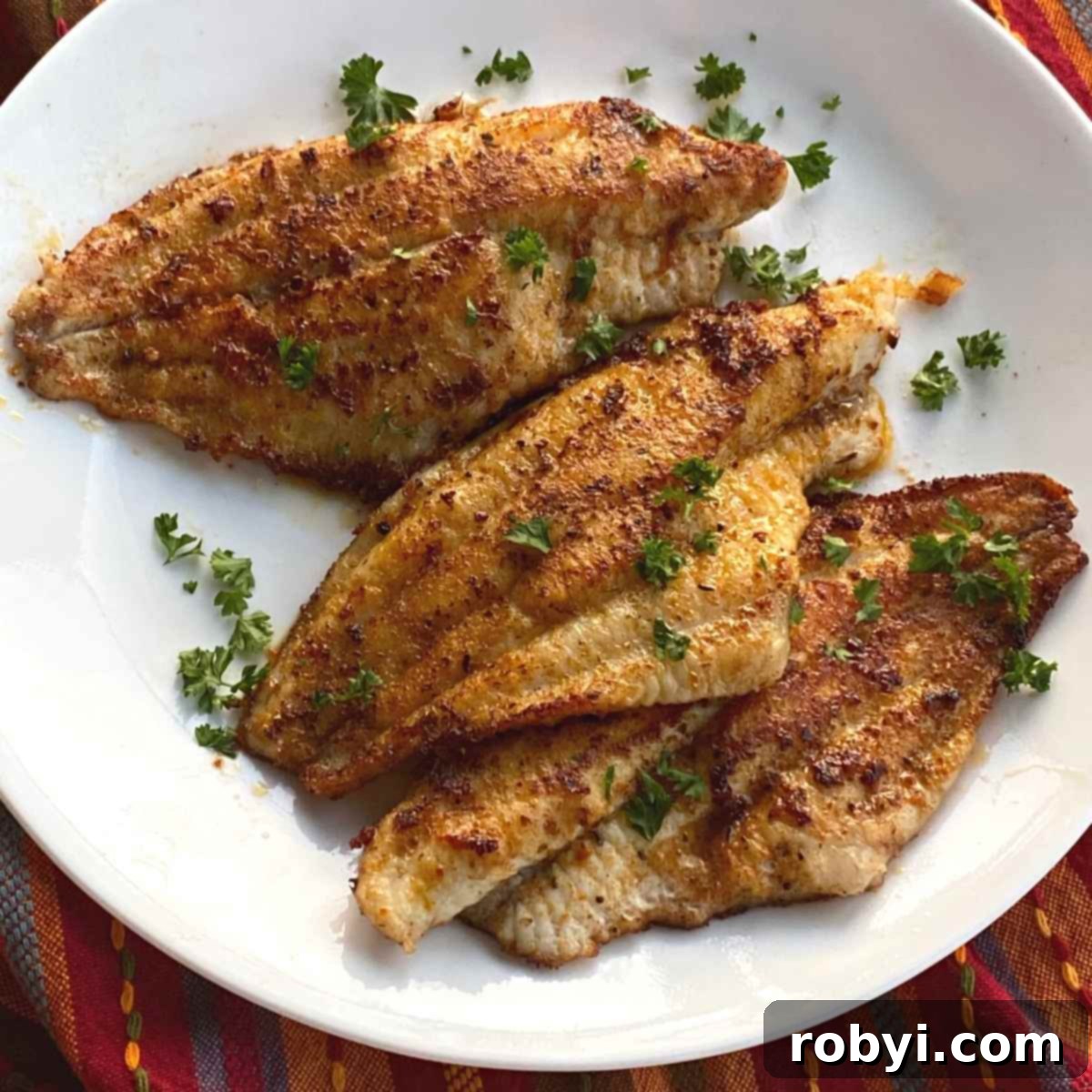This incredibly easy Cajun catfish recipe pan-fries quickly on the stovetop, delivering a burst of authentic Southern flavor in minutes. It’s a remarkably swift and effortless method to prepare this sweet, mild white fish, guaranteeing a meal so delicious your family will undoubtedly ask for seconds.

Discover the Delight of Easy Cajun Catfish: A Weeknight Favorite
Have you overlooked catfish in the grocery store aisles, perhaps favoring other fish like cod? For years, I found myself doing just that, often defaulting to my trusty blackened cod recipe. However, I’m thrilled to report that those days are long behind me!
My past hesitation towards this versatile fish was completely unfounded. The moment I seasoned fresh, responsibly farm-raised catfish fillets with a vibrant blend of Cajun spices and pan-fried them to perfection on the stovetop, I knew I had stumbled upon a true culinary gem. The resulting dish was nothing short of delicious, transforming my perception of this humble fish.
This Cajun catfish is incredibly adaptable. For a healthy, low-carb dinner option, I love serving it alongside Cajun cauliflower rice. Alternatively, when I’m in the mood for something a bit more indulgent and comforting, it pairs wonderfully with a rich one-pot fettuccine alfredo.
Why This Pan-Fried Cajun Catfish Will Become Your New Go-To Recipe
This recipe isn’t just another fish dish; it’s a game-changer for busy weeknights and a fantastic way to introduce more healthy seafood into your diet. Here’s why you’ll absolutely adore it:
- Minimal Ingredients: You’ll need just a handful of staple ingredients, typically 3-4, making grocery shopping a breeze and prep time minimal.
- Lightning Fast: From start to finish, this flavorful meal is ready in a remarkable 15 minutes on your stovetop, perfect for those evenings when time is of the essence.
- Healthy & Wholesome: It’s a naturally healthy choice, being low-carb and keto-friendly, without compromising on taste or satisfaction. Enjoy a guilt-free, protein-packed dinner!
- Family-Approved Flavor: The mild sweetness of the catfish perfectly balances the bold, zesty kick of Cajun spices, creating a flavor profile that appeals to a wide range of palates, including picky eaters.
- Effortless Cooking: Pan-frying offers a simple, mess-free cooking method that yields perfectly crispy edges and tender, moist fish every time.
What Does Catfish Taste Like? Unveiling its Unique Flavor Profile
Catfish is celebrated for its distinctly mild and sweet taste, making it an excellent choice for those who prefer fish without an overly “fishy” aroma or robust flavor. The texture of catfish is moist, wonderfully firm, and less flaky compared to some other white fish varieties. Historically, catfish, being a bottom-dweller, occasionally carried a reputation for a slightly “muddy” taste. However, I can confidently say that this has not been my experience with modern catfish.
These days, the vast majority of catfish found in grocery stores is responsibly farmed rather than wild-caught. This shift in sourcing is incredibly beneficial. When catfish are farm-raised, their diet is carefully controlled, which directly translates to a consistently pleasant, clean, and sweet flavor profile, completely eliminating any concerns about a muddy taste. Furthermore, choosing farm-raised catfish means you can enjoy your meal without worries about mercury content, as the aquaculture industry strictly adheres to rigorous FDA guidelines and standards for sustainably sourced seafood, as detailed by FishWatch. This commitment to quality and safety ensures that catfish is not only delicious but also a healthy and responsible choice for your dinner table.
Essential Ingredients for Your Spicy Cajun Catfish Creation
Crafting this incredible Cajun catfish requires only a few key components. Here’s a closer look at what you’ll need and some tips for selecting the best quality:
- Catfish Fillets: Opt for fresh, skin-on or skinless fillets. Ensure they are boneless for easy eating. The skin, if properly cleaned, is perfectly safe and can even add a lovely crispiness when pan-fried. If catfish isn’t readily available, Basa fish fillets make an excellent substitute, offering a similar mild taste and firm texture. Aim for about 20 ounces for four servings.
- Cajun or Creole Seasoning: This is where the magic happens! You can use your favorite store-bought spicy seasoning blend. Alternatively, we’ve included a fantastic DIY blackened seasoning blend in the recipe card below, allowing you to customize the spice level and flavor to your liking.
- Olive Oil and/or Butter: A combination of healthy fats is crucial for pan-frying the fish to golden perfection. I personally enjoy using 1 tablespoon of each in this recipe—the olive oil provides a high smoke point, while the butter adds a rich, nutty flavor that complements the Cajun spices beautifully. Feel free to use just one or adjust the ratio based on your preference.
For the precise measurements of ingredients and a detailed step-by-step guide, kindly refer to the comprehensive recipe card provided further down the page.
Craft Your Own Authentic Cajun Spice Blend
Creating your own Cajun spice blend from scratch is incredibly rewarding and allows for full control over the flavor and heat. This homemade mix ensures your catfish has that perfectly balanced, robust Southern kick. Here’s what you’ll need for our recommended blend:
- 2 teaspoons paprika: Provides a vibrant color and a mild, sweet peppery base.
- ¼ teaspoon salt: Essential for enhancing all the other flavors.
- 1 teaspoon cayenne pepper: Delivers the characteristic heat of Cajun cuisine. Adjust to your preferred spice level – reduce for milder, increase for hotter.
- 1 teaspoon ground cumin: Adds an earthy, warm undertone that deepens the spice blend.
- 1 teaspoon thyme: Contributes a savory, slightly minty, and aromatic herb note.
- ½ teaspoon white pepper: Offers a sharper, more pungent heat than black pepper, traditional in Cajun cooking.
- ½ teaspoon onion powder: Infuses a foundational savory sweetness without adding moisture.
Combine these spices in a small bowl, mix thoroughly, and store in an airtight container. This blend isn’t just for catfish; it’s fantastic on chicken, shrimp, vegetables, and more!
Expert Tips for Preparing Your Catfish Fillets: Eliminating “Fishy” Odors
Proper preparation is key to ensuring your Cajun catfish is as delicious as possible. The first step is to gently rinse your catfish fillets under cold running water. This helps remove any loose scales or impurities. The most crucial step that follows is to thoroughly pat the fish dry with paper towels. Excess moisture can prevent the fish from getting a beautiful, crispy crust and can also cause the seasoning to clump rather than adhere evenly.
If you’re ever concerned about a “fishy” smell or taste, which typically indicates that the fish isn’t at its absolute freshest, there’s a simple, effective trick used by many chefs: soaking the fish in milk. According to Epicurious, the casein protein in milk effectively binds with trimethylamine, the compound responsible for that characteristic fishy odor. Simply immerse your fillets in whole milk or buttermilk for about 20 minutes. After soaking, discard the milk and pat the fish completely dry before seasoning. You’ll notice a significantly brighter, cleaner aroma and taste.
Of course, this trick is for minor freshness concerns. It’s vital to remember that you should never consume fish that is mushy in texture, discolored, or emits a highly pungent, foul odor. When in doubt, it’s always safest to discard the fish.
Step-by-Step Directions for Perfect Pan-Fried Cajun Catfish
Follow these simple steps to create perfectly cooked, flavorful Cajun catfish on your stovetop:

- Prepare the Fish: Begin by rinsing your catfish fillets under cold water. Then, using paper towels, pat them thoroughly dry on both sides. This step is crucial for achieving a crispy exterior.
- Season Generously: Liberally sprinkle your Cajun or Creole seasoning over both sides of each fillet. Don’t be shy – the seasoning provides much of the flavor! Gently press the spices into the fish to ensure they adhere well. For a delightful sweet and spicy twist, you can spread a thin layer of honey on the fillet before applying the seasoning.
- Heat the Pan: Heat your chosen cooking fat (olive oil, butter, or a combination) in a large skillet over medium-high heat. Wait until the oil shimmers or the butter is fully melted and slightly foamy, indicating it’s hot enough.
- Cook Undisturbed: Carefully place the seasoned catfish fillets into the hot skillet. Cook them undisturbed for 5-6 minutes. This initial cooking phase is vital for developing that beautiful, crispy, blackened crust without burning. Resist the urge to move or flip the fish too early.
- Flip and Finish: Once a rich crust has formed, gently flip the fillets using a thin spatula. Continue cooking for approximately 5 minutes more on the second side. The fish is done when the flesh appears opaque white throughout and flakes easily with a fork. For food safety, the internal temperature of fish should reach 145°F (63°C) when measured with an instant-read thermometer at its thickest part.
Achieving the Perfect Crisp: Best Pans for Pan-Frying Fish
The right pan can make all the difference in achieving that desirable crispy exterior and tender interior for your pan-fried catfish. Several types of skillets are excellent choices for pan-frying and blackening fish:
- Cast Iron Skillet: A classic choice for its superior heat retention and even heat distribution. Cast iron can achieve a wonderfully high temperature, perfect for creating that signature blackened crust. Just ensure it’s well-seasoned to prevent sticking.
- Stainless Steel Skillet: A versatile option that heats up quickly and can withstand high temperatures. Look for a heavy-bottomed stainless steel pan for the best results, as it distributes heat more evenly.
- Non-Stick Skillet: Ideal for beginners or those looking for an easy cleanup. A good quality non-stick pan will ensure the fish doesn’t stick, allowing you to achieve a crispy exterior with less worry.
Regardless of the pan you choose, the key to success lies in proper heating. Always preheat your pan over medium-high heat until it’s thoroughly hot. Then, add a thin layer of olive oil or butter (or both) and wait until it shimmers or just begins to lightly smoke. When the fish hits the pan, it should sizzle immediately – this indicates your pan is at the optimal temperature for developing a delicious crust and preventing the fish from steaming instead of frying.

Delicious Serving Ideas for Your Cajun Catfish
Cajun catfish is incredibly versatile and pairs well with a variety of side dishes, making it easy to create a complete and satisfying meal. Here are some of my favorite ways to serve it:
- Low-Carb Options: For a healthy, carb-conscious meal, serve your catfish with Cajun cauliflower rice, steamed asparagus, sautéed green beans, or a crisp garden salad. A wedge of fresh lemon is always a welcome addition to brighten the flavors.
- Heartier Sides: If you’re not counting carbs, classic pairings like dirty rice, creamy grits, cornbread, or even a side of sweet potato fries complement the spicy fish beautifully.
- Sauces and Toppings: A dollop of homemade tartar sauce, a squeeze of fresh lime juice, or a sprinkle of chopped fresh cilantro or parsley can elevate the dish even further. For an extra kick, a drizzle of hot sauce or a light Creole remoulade would be fantastic.
Storing and Reheating Leftover Cajun Catfish
While this recipe is so quick and easy that cooking only what you need is often the best approach, it’s certainly possible to enjoy leftovers. Here’s how to properly store and reheat any extra catfish to maintain its delicious flavor and texture:
- To Store: Allow any leftover pan-fried catfish to cool completely to room temperature (this prevents condensation and sogginess). Transfer the cooled fish to an airtight storage container and refrigerate promptly. It will remain fresh and delicious for 2-3 days.
- To Reheat: For best results, gently reheat the fish in a skillet over medium-low heat. This method helps the exterior regain some crispness. Cook until just warmed through, being careful not to overcook, which can dry out the fish. If using a microwave, place the fish on a microwave-safe plate, cover it loosely to retain moisture, and cook at 50% power in short 20-30 second bursts until warm.
Keep in mind that reheated fish, especially fried fish, may not have the exact same crisp texture as when freshly made, but the flavors will still be wonderful!

Explore More Easy & Flavorful Fish Recipes
If you loved this Cajun catfish recipe, you’re in for a treat! We have a wide array of other simple and delicious fish recipes that are perfect for any night of the week. Expand your culinary repertoire with these fresh and exciting options:
- Bourbon Marinated Salmon – Easy Recipe!
- Baked Corvina Recipe with Lemon Pepper Crust
- Baked Turbot Fillets with Mustard Dill Sauce
- Baked Lemon Pepper Tilapia Recipe
Easy Pan-Fried Cajun Catfish Recipe

This quick and flavorful pan-fried catfish recipe brings the vibrant tastes of Cajun cuisine directly to your kitchen. Featuring sweet, mild white fish generously seasoned with bold spices, it’s a healthy, low-carb dinner option that’s incredibly easy to make and guaranteed to be a family favorite.
- Prep Time: 5 minutes
- Cook Time: 10 minutes
- Total Time: 15 minutes
- Servings: 4 servings
- Author: Marjory Pilley
Ingredients
- 20 ounces catfish fillets
- 1-2 Tablespoons Cajun Spice Blend (or prepare the homemade spice blend below)
- 2 Tablespoons olive oil and/or butter
Homemade Cajun Spice Blend
- 2 teaspoons paprika
- ¼ teaspoon salt
- 1 teaspoon cayenne pepper
- 1 teaspoon ground cumin
- 1 teaspoon thyme
- ½ teaspoon white pepper
- ½ teaspoon onion powder
Instructions
- If opting for the homemade Cajun spice blend, combine all listed spices (paprika, salt, cayenne pepper, ground cumin, thyme, white pepper, onion powder) in a small bowl. Mix them thoroughly until well combined, then set aside.
- Rinse the catfish fillets under cold running water and pat them completely dry on both sides using paper towels. This step is essential for achieving a crispy exterior.
- Generously sprinkle the Cajun seasoning blend over both sides of each fish fillet. Gently press the seasoning into the flesh to ensure it adheres properly. Adjust the amount of seasoning according to your desired spice level.
- Heat the olive oil and/or butter in a large skillet over medium-high heat. Allow the fat to heat until it shimmers and is hot but not smoking, indicating it’s ready for frying.
- Carefully place the seasoned catfish fillets into the hot skillet. Cook the fish undisturbed for 5-6 minutes on the first side to allow a golden, crispy crust to form.
- Using a thin spatula, flip the fillets gently and continue to cook for approximately 5 minutes more on the second side. The fish is cooked through when it appears opaque white throughout, flakes easily with a fork, and reaches an internal temperature of 145°F (63°C).
Last Step: We’d love to hear from you! Please consider leaving a rating and comment below to let us know how you enjoyed this recipe. Your feedback helps our business thrive and allows us to continue providing more delicious, free recipes!
Notes
- For more expert tips and step-by-step pictures, refer to the sections above in this article.
- Storage: While best enjoyed fresh, leftover catfish can be stored in an airtight container in the refrigerator for 2-3 days.
- Reheating: Gently reheat in a skillet over medium-low heat until just warmed through, or microwave covered at 50% power in 20-30 second bursts to prevent drying.
Nutrition Information (Per Serving)
- Calories: 205 kcal
- Carbohydrates: 2g
- Protein: 24g
- Fat: 11g
- Saturated Fat: 2g
- Polyunsaturated Fat: 2g
- Monounsaturated Fat: 6g
- Cholesterol: 82mg
- Sodium: 208mg
- Potassium: 555mg
- Fiber: 1g
- Sugar: 1g
- Vitamin A: 802IU
- Vitamin C: 2mg
- Calcium: 31mg
- Iron: 1mg
Please note: Nutritional information provided is an estimate based on common ingredient values and may vary. Always consult a healthcare professional for dietary advice.
Nutritional and Food Safety Disclaimer
Stay Connected for More Healthy Recipes!
Craving more easy, healthy, and carb-conscious meals and expert cooking tips? Don’t miss out on new recipes delivered straight to your inbox each week!
Join Our Email List Here >
